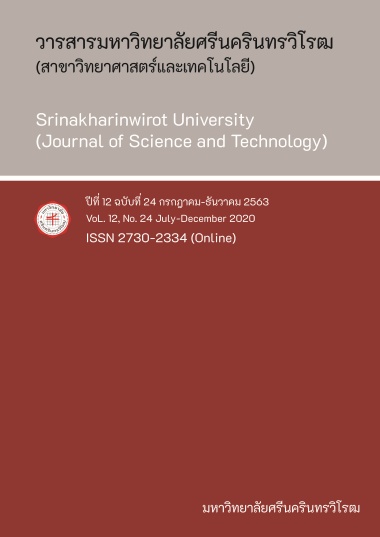ผลของสารสกัดพืชสมุนไพรและระยะเวลาการแช่ในสารสกัดพืชสมุนไพรต่อคุณภาพของผลิตภัณฑ์มะละกอแก้วเสริมสารสกัดพืชสมุนไพร EFFECT OF HERBAL PLANT EXTRACTS AND IMMERSION TIMES ON THE QUALITY OF SWEET DEHYDRATED GREEN PAPAYA FORTIFIED WITH THE EXTRACTS
คำสำคัญ:
มะละกอ, ผลิตภัณฑ์มะละกอแก้ว, สารสกัดพืชสมุนไพร, ระยะเวลาการแช่บทคัดย่อ
งานวิจัยนี้มีวัตถุประสงค์เพื่อศึกษาผลของสารสกัดพืชสมุนไพร จำนวน 2 ชนิด คือ ดอกอัญชัน (Clitoria ternatea L.) และดอกคำฝอย (Carthamus tinctorius L.) และระยะเวลาในการแช่ชิ้นมะละกอในสารสกัดพืชสมุนไพรต่อสมบัติทางเคมี กายภาพ ปริมาณสารประกอบฟีนอลและฤทธิ์การต้านอนุมูลอิสระของผลิตภัณฑ์มะละกอแก้วเสริมสารสกัดพืชสมุนไพร ผลการศึกษาพบว่า ระยะเวลาการแช่ชิ้นมะละกอในสารสกัดพืชสมุนไพรที่เพิ่มขึ้น ส่งผลให้ค่าความสว่าง (L*) ของมะละกอแก้วเสริมสารสกัดดอกอัญชันและดอกคำฝอยมีค่าลดลงแต่ปริมาณของแข็งที่ละลายได้ทั้งหมดมีค่าเพิ่มขึ้น ในขณะที่ระยะเวลาในการแช่ชิ้นมะละกอในสารสกัดพืชสมุนไพรทั้งสองชนิดไม่มีผลต่อค่าความแข็งของชิ้นมะละกอแก้วอย่างมีนัยสำคัญทางสถิติระดับความเชื่อมั่น 95 เปอร์เซ็นต์ (P>0.05) ระยะเวลาการแช่ชิ้นมะละกอในสารสกัดพืชสมุนไพรที่เพิ่มขึ้นส่งผลให้มะละกอแก้วมีปริมาณสารประกอบฟีนอล ฤทธิ์ต้านอนุมูลอิสระ DPPH Radical-Scavenging Activity (DPPH) และ Ferric Reducing Antioxidant Power (FRAP) มีค่าสูงขึ้นอย่างมีนัยสำคัญทางสถิติที่ระดับความเชื่อมั่น 95 เปอร์เซ็นต์ (P≤0.05) โดยระยะเวลาการแช่ที่ 90 นาที มีสมบัติการต้านอนุมูลอิสระสูงที่สุด รองลงมาคือ 60 และ 30 นาที ตามลำดับ
และมะละกอแก้วเสริมสารสกัดดอกอัญชันมีปริมาณสารประกอบฟีนอลและฤทธิ์ต้านอนุมูลอิสระ (DPPH และ FRAP) สูงกว่ามะละกอแก้วเสริมสารสกัดจากดอกคำฝอย ดังนั้นผลิตภัณฑ์มะละกอแก้วเสริมสารสกัดดอกอัญชันและดอกคำฝอยจึงเป็นผลิตภัณฑ์อาหารแปรรูปจากมะละกอดิบรูปแบบใหม่ที่มีประโยชน์ต่อสุขภาพ
Downloads
References
[2] Ikram, E.H.K., Stanley, R., Netzel, M., & Fanning, K. (2015, August). Phytochemicals of papaya and its traditional health and culinary uses-A review. Journal of Food Composition and Analysis, 41, 201-211.
[3] Júnior, E.V.S., Melob, L.L., Medeirosa, R.A.B., Barrosc, Z.M.P., & Azoubelb, P.M. (2018, November). Influence of ultrasound and vacuum assisted drying on papaya quality parameters. LWT-Food Science and Technology, 97, 317-322.
[4] Soranastaporn, S., & Rimphadee, P. (2013, November). Bangkok food culture: A culinary journey from street food to restaurants. Create Space Independent Publishing Platform, Bangkok, Thailand.
[5] Parker, T.L., Esgro, S.T., Miller, A.S., Myers, L.E., Meister, R.A., Toshkov, S.A., & Engeseth, N.J. (2010, February). Development of an optimised papaya pulp nectar using a combination of irradiation and mild heat. Food Chemistry, 118, 861-869.
[6] Udomkun, P., Nagle, M., Mahayothee, B., Nohr, D., Koza, A., & Müller, J. (2015, March). Influence of air drying properties on non-enzymatic browning, major bio-active compounds and antioxidant capacity of osmotically pretreated papaya. LWT-Food Science and Technology, 60(2), 914-922.
[7] Lieba, V.M., Esquivelb, P., Castillob, E.C., Carlea, R., & Steingassa, C.B. (2018, May). GC–MS profiling, descriptive sensory analysis, and consumer acceptance of Costa Rican papaya (Carica papaya L.) fruit purees. Food Chemistry, 248, 238-246.
[8] Pasukamonset, P., Kwon, O., & Adisakwattana, S. (2016, December). Alginate-based encapsulation of polyphenols from Clitoria ternatea petal flower extract enhances stability and biological activity under simulated gastrointestinal conditions. Food Hydrocolloids, 61, 772-779.
[9] Rodriguez-Amaya, D.B. (2016, February). Natural food pigments and colorants. Current Opinion in Food Science, 7, 20-26.
[10] Azima, A.M.S., Noriham, A., & Manshoor, N. (2017, November). Phenolics, antioxidants and color properties of aqueous pigmented plant extracts: Ardisia colorata var. elliptica, Clitoria ternatea, Garcinia mangostana and Syzygium cumini. Journal of Functional Foods, 38, 232-241.
[11] Mandade, R., Sreenivas, S.A., & Choudhury, A. (2011, July). Radical scavenging and antioxidant activity of Carthamus tinctorius extracts. Free Radicals and Antioxidants, 1(3), 87-93.
[12] Machewad, G.M., Ghatge, P., Chappalwar, V., Jadhav, B., & Chappalwar, A. (2012, August). Studies on extraction of safflower pigments and its utilization in ice cream. Journal of Food Process and Technology, 3(8), 172-174.
[13] Kazuma, K., Takahashi, T., Sato, K., Takeuchi, H., & Matsu-moto, T.T.O. (2000, August). Quinochalcones and flavonoids from fresh florets in different cultivars of Carthamus tinctorius L. Bioscience, Biotechnology, and Biochemistry, 64, 1588-1599.
[14] Chang, S.K., Alasalvar, C., & Shahidi. F. (2016, March). Review of dried fruits: Phytochemicals, antioxidant efficacies, and health benefits. Journal of Functional Foods, 21, 113-132.
[15] Rongkom, H., Dajanta, K., Satsawathawanwong, N., Naiton, K., Kawpongpok, K., & Petchaidum, C. (2015, November). Impact of extraction procedure on the antioxidant properties of red roselle, butterfly pea and safflower. 7th International Science, Social Sciences, Engineering and Energy Conference, 24-26 November, 2015, Wangchan Riverview Hotel, Phitsanulok, Thailand.
[16] Association of Official Analytical Chemists. (2000). Official Method of Analysis of AOAC International. The Association of Official Analytical Chemists: Washington D.C., USA.
[17] Lugue-Rodriguez, J.M., Luque de Castro, M.D., & Perez-Juan, P. (2007, October). Dynamic superheated liquid extraction of anthocyanins and other phenolic from red grape skins of wine making residues. Bioresource Technology, 98(14), 2705-2713.
[18] Nuengchamnong, N., Krittasilp, K., & Ingkaninan, K. (2009, December). Rapid screening and identification of antioxidants in aqueous extracts of Houttuynia cordata using LC-ESI-MS coupled with DPPH assay. Food Chemistry, 117, 750-756.
[19] Maier, T., Schieber, A., Kammerer, D. R., & Carle, R. (2009, February). Residues of grape (Vitis vinifera L.) seed oil production as a valuable source of phenolic antioxidants. Food Chemistry, 112, 551-559.
[20] Udomkun, P., Nagle, M., Argyropoulos, D., Mahayothee, B., Latif, S., & Müller, J. (2016, April). Compositional and functional dynamics of dried papaya as affected by storage time and packaging material. Food Chemistry, 196, 712-719.
[21] Karunamoorthi, K., Kim, H.M., Jegajeevanram, K., Xavier, J., & Vijayalakshmi, J. (2014, March). Papaya: A gifted nutraceutical plant-a critical review of recent human health research. TANG Humanitas Traditional Medicine, 4(1), 1-17.
[22] Adsare, S.R., Bellary, A.N., Sowbhagya, H.B., Baskaran, R., Prakash, M., & Rastogi, N.K. (2016, April). Osmotic treatment for the impregnation of anthocyanin in candies from Indian gooseberry (Emblica officinalis). Journal of Food Engineering, 175, 24-32.
[23] Kaisoon, O., Siriamornpun, S., Weerapreeyakul, N., & Meeso, N. (2011, April). Phenolic compounds and antioxidant activities of edible flowers from Thailand. Journal of Functional Foods, 3, 88-99.
[24] Gayosso-García Sancho, L.E., Yahia, E.M., & González-Aguilar, G.A. (2011, June). Identification and quantification of phenols, carotenoids, and vitamin C from papaya (Carica papaya L., cv. Maradol) fruit determined by HPLC-DAD-MS/MS-ESI. Food Research International, 44, 1284-1291.
[25] Calvache, J.N., Cueto, M., Farroni, A., Pla, M.E., & Gerschenson, L.N. (2016, December). Antioxidant characterization of new dietary fiber concentrates from papaya pulp and peel (Carica papaya L.). Journal of Functional Foods, 27, 319-328.
[26] Benzie, I.F.F., & Strain, J.J. (1998, January). The ferric reducing ability of plasma (FRAP) as a measure of Antioxidant power: The FRAP assay. Analytical Biochemistry, 239, 70-76.
[27] Fernandes, L., Casal, S., Pereira, J.A., Saraiva, J.A., & Ramalhosa, E. (2017, July). Edible flowers: A review of the nutritional, antioxidant, antimicrobial properties and effects on human health. Journal of Food Composition and Analysis, 60, 38-50.
Downloads
เผยแพร่แล้ว
How to Cite
ฉบับ
บท
License
วารสารมหาวิทยาลัยศรีนครินทรวิโรฒ สาขาวิทยาศาสตร์และเทคโนโลยี อยู่ภายใต้การอนุญาต Creative Commons Attribution-NonCommercial-NoDerivs 4.0 International (CC-BY-NC-ND 4.0) เว้นแต่จะระบุไว้เป็นอย่างอื่น โปรดอ่านหน้านโยบายของวารสารสำหรับข้อมูลเพิ่มเติมเกี่ยวกับการเข้าถึงแบบเปิด ลิขสิทธิ์ และการอนุญาต


